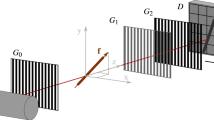Zusammenfassung
The X-ray dark-field can be measured with a grating interferometer. For oriented structures like fibers, the signal magnitude depends on the relative orientation between fiber and gratings. This allows to analytically reconstruct the fiber orientations at a micrometer scale. However, there currently exists no implementation of a clinically feasible trajectory for recovering the full 3D orientation of a fiber. In principle, a helical trajectory can be suitable for this task. However, as a first step towards dark-field imaging in a helix, a careful analysis of the signal formation is required. Towards this goal, we study in this paper the impact of the grating orientation. We use a recently proposed 3D-projection model and show that the projected dark-field scattering at a single volume point depends on the grating sensitivity direction and the helix geometry. More specifically, the dark-field signal on a 3D trajectory always consists of a linear combination of a constant and an angular-dependent component.
Access this chapter
Tax calculation will be finalised at checkout
Purchases are for personal use only
Preview
Unable to display preview. Download preview PDF.
Similar content being viewed by others
Literatur
Jensen TH, Bech M, Bunk O, et al. Directional X-ray dark-field imaging. Phys Med Biol. 2010;55(12):3317.
Revol V, Kottler C, Kaufmann R, et al. Orientation-selective X-ray dark field imaging of ordered systems. J Appl Phys. 2012;112(11):114903.
Scherer K, Yaroshenko A, Bölükbas DA, et al. X-ray dark-field radiography-in-vivo diagnosis of lung cancer in mice. Sci Rep. 2017;7(1):402.
Hellbach K, Baehr A, Marco F, et al. Depiction of pneumothoraces in a large animal model using X-ray dark-field radiography. Sci Rep. 2018;8(1):2602.
Wieczorek M, Schaff F, Jud C, et al. Brain connectivity exposed by anisotropic X-ray dark-field tomography. Sci Rep. 2018;8.
Bayer FL, Hu S, Maier A, et al. Reconstruction of scalar and vectorial components in X-ray dark-field tomography. Procs Nat Acad Sci. 2014;111(35):12699{12704.
Hu S, Riess C, Hornegger J, et al. 3D tensor reconstruction in X-ray dark-field tomography. Proc BVM. 2015; p. 492–497.
Malecki A, Potdevin G, Biernath T, et al. X-ray tensor tomography. Europhys Lett. 2014;105(3):38002.
Vogel J, Schaff F, Fehringer A, et al. Constrained X-ray tensor tomography reconstruction. Optics Express. 2015;23(12):15134{15151.
Wieczorek M, Schaff F, Pfeiffer F, et al. Anisotropic X-ray dark-field tomography: a continuous model and its discretization. Phys Rev Lett. 2016;117(15):158101.
Schaff F, Prade F, Sharma Y, et al. Non-iterative directional dark-field tomography. Sci Rep. 2017;7(1):3307.
Hu S, Felsner L, Maier A, et al. A 3-D projection model for X-ray dark-field imaging. arXiv:181104457. 2018;.
Author information
Authors and Affiliations
Corresponding author
Editor information
Editors and Affiliations
Rights and permissions
Copyright information
© 2019 Springer Fachmedien Wiesbaden GmbH, ein Teil von Springer Nature
About this paper
Cite this paper
Felsner, L., Hu, S., Ludwig, V., Anton, G., Maier, A., Riess, C. (2019). On the Characteristics of Helical 3D X-Ray Dark-Field Imaging. In: Handels, H., Deserno, T., Maier, A., Maier-Hein, K., Palm, C., Tolxdorff, T. (eds) Bildverarbeitung für die Medizin 2019. Informatik aktuell. Springer Vieweg, Wiesbaden. https://doi.org/10.1007/978-3-658-25326-4_59
Download citation
DOI: https://doi.org/10.1007/978-3-658-25326-4_59
Published:
Publisher Name: Springer Vieweg, Wiesbaden
Print ISBN: 978-3-658-25325-7
Online ISBN: 978-3-658-25326-4
eBook Packages: Computer Science and Engineering (German Language)




